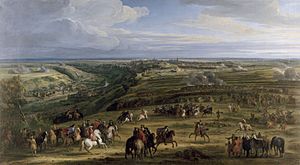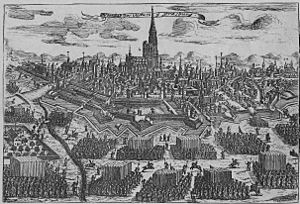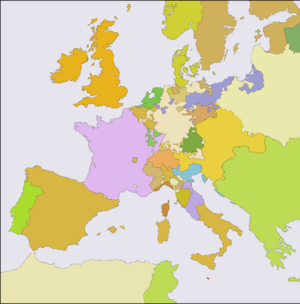War of the Reunions facts for kids
Quick facts for kids War of the Reunions |
|||||||||
|---|---|---|---|---|---|---|---|---|---|
| Part of the wars of Louis XIV | |||||||||
 The Siege of Luxembourg |
|||||||||
|
|||||||||
| Belligerents | |||||||||
Co-belligerent: |
|||||||||
| Commanders and leaders | |||||||||
The War of the Reunions was a short war that happened between 1683 and 1684. It involved France, Spain, and the Holy Roman Empire. The city of Genoa also played a small part. This conflict was part of King Louis XIV's efforts to make France's borders stronger and safer.
Even after a peace treaty in 1678, King Louis XIV kept a very large army. This was unusual for the time. In 1681, his troops took over Strasbourg. In 1682, they occupied the Principality of Orange. When the war started in 1683, France supported the Ottomans in their war against Austria. This allowed Louis to capture Luxembourg. He also made his control stronger in the Alsace region.
The war ended with the Truce of Ratisbon. This truce marked the biggest land gains for France under Louis XIV. After this war, other European countries realized they needed to work together. They wanted to stop France from expanding further. This led to the creation of the Grand Alliance in 1688. This group fought against France in later wars, like the Nine Years' War.
Why the War Started
After several peace treaties, France had gained new lands. These included areas in the Rhineland and near the Spanish Netherlands. When a town was given to France, it usually included the lands around it. But the treaties often did not clearly draw the exact borders.
King Louis XIV wanted to make sure France got all the land it was owed. He set up special courts called "Chambers of Reunion". These courts were made up of French lawyers. They decided if France had received all its territory. Usually, these courts demanded more land for France. Since these were often small towns, other countries did not always protest.
However, two important cities, Strasbourg and Luxembourg, were still part of the Holy Roman Empire. France controlled much of the land around them. But the bridge over the Rhine at Strasbourg had been used by enemy troops. They had invaded Alsace three times during the Franco-Dutch War. Luxembourg also controlled areas that France had taken from the Spanish Netherlands.
Louis XIV believed that owning Strasbourg and Luxembourg was key to protecting his new lands. At this time, the Holy Roman Empire's troops were busy fighting the Ottomans in the east. This was a huge war called the Great Turkish War. This meant the Empire could not easily send troops to fight France in the west.
French forces took Strasbourg on September 30, 1681. It officially became part of France. Marshal Boufflers also started to attack Luxembourg. But Louis decided it was not a good idea to attack another Christian kingdom while it was fighting the Ottomans. So, in March 1682, Boufflers pulled his troops back. However, on September 12, 1683, a combined army defeated the Ottomans. This happened at the Battle of Vienna, forcing them to retreat.
The War Begins
After stopping the Ottomans, the Habsburgs could finally focus on the west. Spain declared war on France on October 26, 1683. On the night of November 3-4, a French army entered the Spanish Netherlands. This army was led by Humières. They surrounded Courtrai, which surrendered on November 6. Then, they moved to Diksmuide, which gave up without a fight on November 10.
Later, in December, another French force attacked Luxembourg. They fired many mortar shells at the city. But winter was coming, and the city did not surrender. So, the French troops pulled back.
Louis XIV started the siege of Luxembourg again in April 1684. He had help from his expert in siege warfare, Sébastien le Prestre de Vauban. The 2,500 defenders of Luxembourg surrendered on June 3. However, fighting continued in other places. The war finally ended with the Truce of Ratisbon on August 15, 1684. France kept the lands it had taken during the war, including Strasbourg and Luxembourg.
This war was short, but it was known for being very harsh. King Louis XIV used violence on purpose. He wanted to force his enemies to surrender quickly. For example, a French commander was ordered to burn 20 villages. This was because the Spanish had destroyed two barns in French villages. The order was to leave no house standing.
Genoa's Role
There was also a separate conflict involving the Republic of Genoa. Genoese bankers had a long history of lending money to Spain. They had done this since the 1500s. During the recent war, Genoa allowed Spain to hire soldiers from its territory. They also let Spain use their port to build ships for the Spanish navy.
As a punishment, a French fleet left the port of Toulon on May 5, 1684. This fleet was led by Admiral Abraham Duquesne. They began to attack Genoa on May 17, 1684. The attack lasted for 12 days, with only a short break for talks. By the time it ended on May 28, two-thirds of the city had been destroyed.
Peace and What Happened Next
King Louis XIV did not send help to the Holy Roman Empire against the Ottomans. He even sent secret messages to encourage the Ottomans. However, people at the time felt it was wrong for him to keep fighting the Empire in the west.
So, Louis agreed to the Truce of Ratisbon. This agreement promised 20 years of peace between France and the Holy Roman Empire. Louis also asked his cousin, Charles II of England, to help settle the border disagreements.
This war, like earlier ones, did not fully solve the problems between the French Bourbon dynasty and the Spanish and Austrian Habsburg dynasty. This short but harsh conflict was one of the events that led to the longer Nine Years' War.
See also
 In Spanish: Guerra de las Reuniones para niños
In Spanish: Guerra de las Reuniones para niños



